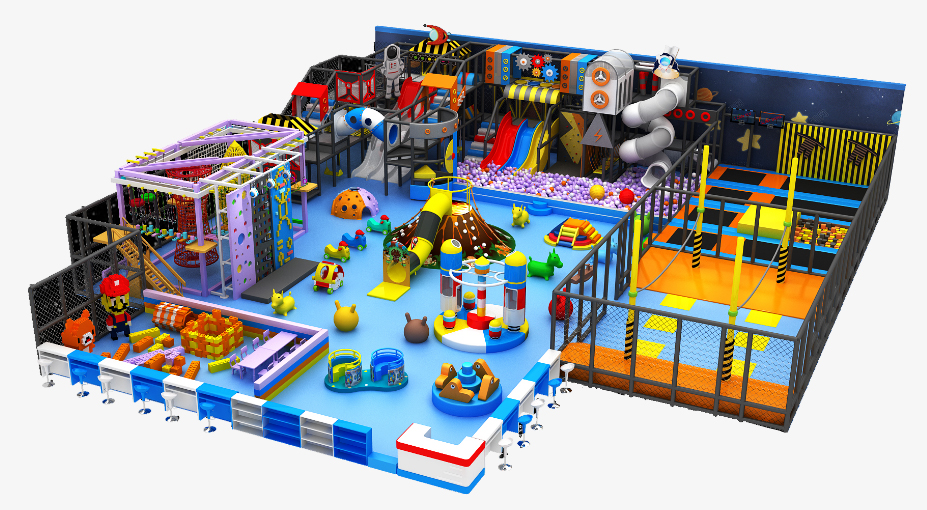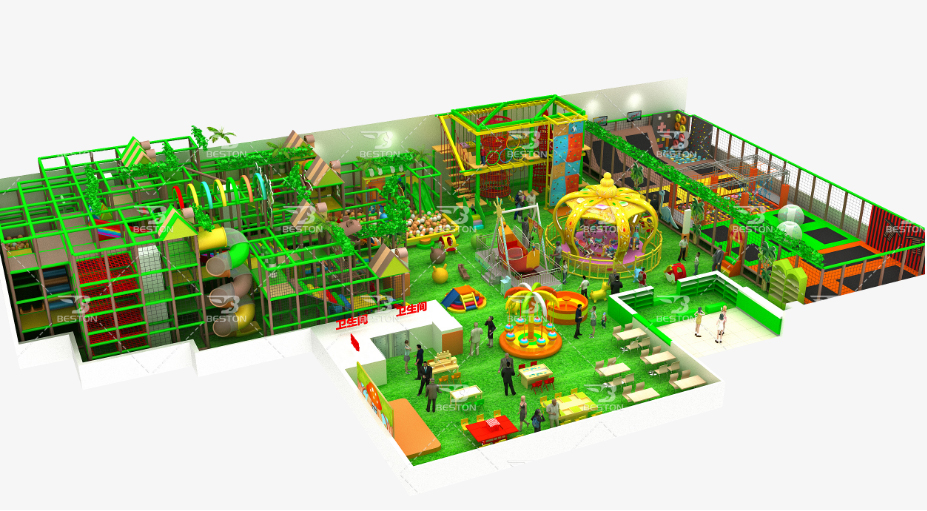Playland equipment, also known as playground equipment, is an essential component of recreational spaces designed to provide children and sometimes adults with opportunities for physical activity, social interaction, and imaginative play. Playland equipment can be found in various settings, including public parks, schools, daycare centers, amusement parks, and indoor play areas. It offers a wide array of play structures and elements that cater to different age groups and interests. In this article, we will explore the diverse world of playland equipment, its benefits, and the key features that make it an integral part of joyful play spaces.
1. Types of Playland Equipment:
Playland equipment encompasses a broad spectrum of play structures, each designed to engage children’s minds and bodies in different ways. Some common types of playland equipment include:
a. Swings: Swings are classic playground favorites, consisting of a suspended seat attached to chains or ropes. Swinging promotes sensory integration, balance, and coordination while providing a sense of freedom and exhilaration.
b. Slides: Slides come in various sizes and shapes, allowing children to experience the thrill of descending from elevated platforms. Sliding enhances spatial awareness and motor skills while encouraging social interaction as kids wait for their turn.

c. Climbing Structures: Climbing structures, such as climbing walls, rope courses, and ladders, challenge children’s physical abilities, strength, and problem-solving skills. They foster confidence and resilience as kids conquer various climbing challenges.
d. Playhouses and Playsets: Playhouses and playsets mimic real-life settings, such as houses, castles, or pirate ships, encouraging imaginative play and storytelling. They often come with interactive features like steering wheels, telescopes, and play panels.
e. Spinner Equipment: Spinners, also known as merry-go-rounds or roundabouts, provide a thrilling spinning experience, promoting balance and vestibular stimulation. They encourage cooperative play as children work together to keep the spinner in motion.
f. Spring Riders: Spring riders are animal-shaped seats attached to a spring base, allowing children to enjoy gentle rocking motions. They enhance balance and coordination while sparking imaginative play.
g. Sand and Water Play: Sandboxes and water play areas offer tactile experiences that foster creativity and sensory exploration. Children can build sandcastles, dig, and experiment with water flow.
h. Musical Play Equipment: Musical play equipment includes outdoor musical instruments, such as drums, chimes, and xylophones. It encourages creativity, auditory development, and collaboration as children create their own melodies.
i. Fitness and Obstacle Courses: Fitness and obstacle courses challenge children to navigate through various physical challenges, promoting strength, agility, and endurance.
2. Benefits of Playland Equipment:
Playland equipment plays a crucial role in children’s physical, social, emotional, and cognitive development. Some of the key benefits of playland equipment include:
a. Physical Development: Playland equipment encourages children to engage in physical activities that promote gross motor skills, coordination, balance, and strength.
b. Social Interaction: Playgrounds provide a natural setting for children to interact, make friends, and develop social skills such as cooperation, communication, and conflict resolution.
c. Imaginative Play: Playland equipment stimulates children’s imagination and creativity, allowing them to role-play, invent stories, and explore their world in a safe and supportive environment.
d. Sensory Stimulation: Many playland equipment elements offer tactile, visual, and auditory experiences, stimulating various senses and supporting sensory development.
e. Cognitive Skills: Playland equipment presents children with problem-solving opportunities, spatial reasoning challenges, and opportunities for strategic thinking.
f. Emotional Well-being: Playgrounds offer opportunities for unstructured play, which promotes stress relief, emotional expression, and a sense of well-being.

3. Safety and Design Considerations:
Safety is a paramount concern in playland equipment design. Playgrounds must adhere to safety standards and guidelines to minimize the risk of injuries. Some key safety considerations include:
a. Safety Surfacing: The playground surface should be impact-absorbing and free from hazards to cushion falls and reduce injury risk.
b. Age-Appropriate Design: Playland equipment should be designed with specific age groups in mind to ensure that the challenges and features are suitable for the intended users.
c. Maintenance and Inspections: Regular maintenance and inspections are essential to keep playland equipment in safe working condition and identify potential hazards promptly.
d. Inclusive Design: Inclusive playgrounds ensure that children of all abilities can access and enjoy the play equipment, promoting a sense of belonging and integration.
e. Quality and Durability: Playland equipment should be constructed with high-quality materials and built to withstand weather conditions and heavy use.
4. Trends in Playland Equipment:
In recent years, several trends have emerged in playland equipment design to enhance the play experience and cater to evolving preferences:
a. Nature-Inspired Play: Playland equipment designs that incorporate natural elements like wooden structures, treehouses, and boulder climbing walls, encouraging a connection with nature.
b. Adventure Playgrounds: Adventure playgrounds offer challenging and unconventional play experiences, promoting risk-taking and resilience.
c. Electronic Interactive Play: Some playland equipment now integrates interactive electronic elements, such as sensory play panels with touch-sensitive features.
d. Themed Playgrounds: Themed playgrounds with characters from popular movies, cartoons, or books create immersive play experiences.
e. Outdoor Fitness Equipment: In addition to traditional play elements, some playland designs include outdoor fitness equipment for children and adults to engage in physical exercise.
Conclusion:
Playland equipment plays a vital role in creating inclusive and engaging play spaces where children can develop physical skills, socialize, and explore their creativity. From swings and slides to climbing structures and musical play elements, the diverse range of playland equipment from Bestonplayground.com offers endless possibilities for joyful play experiences. Thoughtful design, safety considerations, and a commitment to providing stimulating play environments ensure that playland equipment remains a cherished and essential feature of parks, schools, and communities worldwide.
